Veterinary M edicine
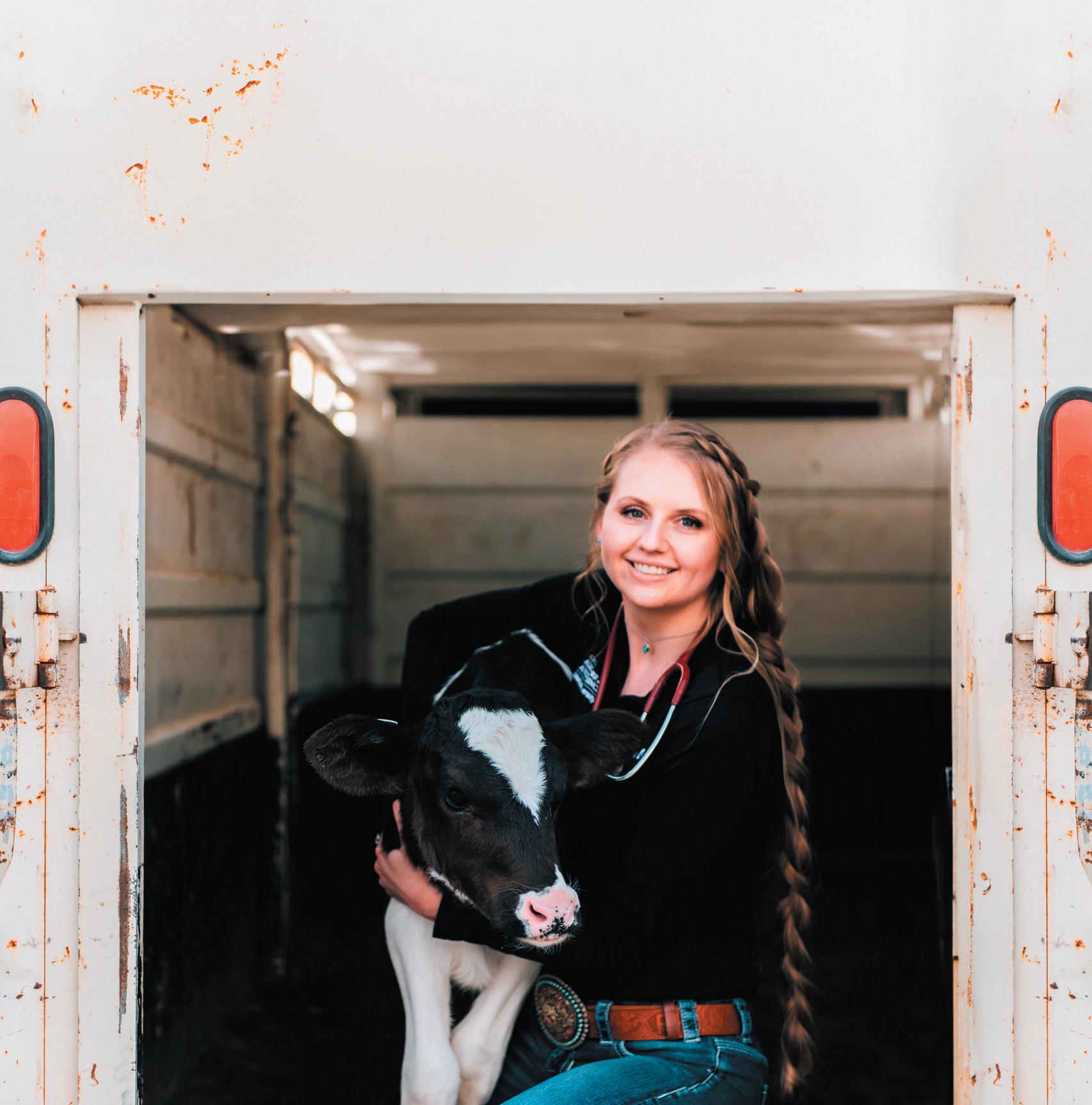
Winter 2023
WE TEACH WHAT YOU LOVE.
{
}
MAGAZINE UTAH STATE UNIVERSITY COLLEGE of
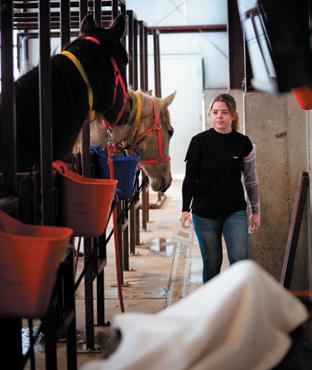

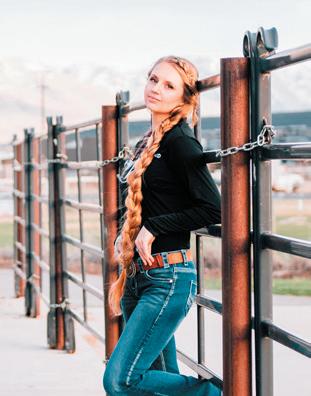
IN THE COLLEGE
Students Return for Equine Clinical Rotation at USU 2
Class of 2023 4
USU College of Veterinary Medicine
Dean's Advisory Board 5
Interim Dean Dirk Vanderwall Named Utah Veterinarian of the Year 9
FACULTY/STAFF
Meet Cathleen Kovarik, the College’s New Director of Admissions 10
STUDENT PROFILES
Larrea Cottingham 11
Mystery Case 13
Leah Shumway 14
ALUMNI
Going Home and Giving Back with Rachel Keckler Hanson 16
IN THE FIELD
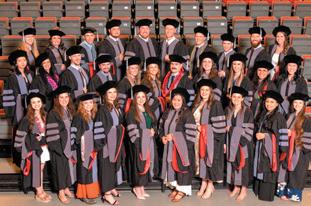

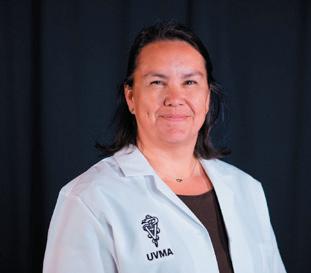
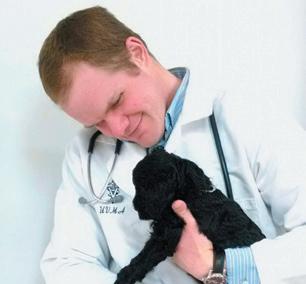
TABLE OF CONTENTS
the Mudhole
Memorial
Students
Message from Development
In its programs and activities, including in admissions and employment, Utah State University does not discriminate or tolerate discrimination, including harassment, based on race, color, religion, sex, national origin, age, genetic information, sexual orientation, gender identity or expression, disability, status as a protected veteran, or any other status protected by University policy, Title IX, or any other federal, state, or local law. Utah State University is an equal opportunity employer and does not discriminate or tolerate discrimination including harassment in employment including in hiring, promotion, transfer, or termination based on race, color, religion, sex, national origin, age, genetic information, sexual orientation, gender identity or expression, disability, status as a protected veteran, or any other status protected by University policy or any other federal, state, or local law. Utah State University does not discriminate in its housing offerings and will treat all persons fairly and equally without regard to race, color, religion, sex, familial status, disability, national origin, source of income, sexual orientation, or gender identity. Additionally, the University endeavors to provide reasonable accommodations when necessary and to ensure equal access to qualified persons with disabilities. The following individuals have been designated to handle inquiries regarding the application of Title IX and its implementing regulations and/or USU’s non-discrimination policies: Executive Director of the Office of Equity, Alison Adams-Perlac, alison.adams-perlac@usu.edu, Title IX Coordinator, Hilary Renshaw, hilary.renshaw@usu.edu, Old Main Rm. 161, 435-797-1266. For further information regarding non-discrimination, please visit equity.usu. edu,or contact: U.S. Department of Education, Office of Assistant Secretary for Civil Rights, 800-421-3481, ocr@ed.gov or U.S. Department of Education, Denver Regional Office, 303-844-5695 ocr.denver@ed.gov. Issued in furtherance of Cooperative Extension work, acts of May 8 and June 30, 1914, in cooperation with the U.S. Department of Agriculture, Kenneth L. White, Vice President for Extension and Agriculture, Utah State University. PUBLICATION INFORMATION ELIZABETH R. CANTWELL President, Utah State University DR. DIRK VANDERWALL Interim Dean of the College of Veterinary Medicine NIKLAS AARDEMA Director of Development MICHAEL BISHOP Director of Students LYNNETTE HARRIS Editor/Writer MICHAEL WERNERT Graphic Designer ETHAN BRIGHTBILL Writer/Marketing Assistant WE TEACH WHAT YOU LOVE. On the cover: Rachel Keckler Hanson. Photo by Lauren Anderson Photography.
Jumping Into
18 Pet
Giving 20 Caring for
Is No Act 21
21
INTERIM DEAN’S MESSAGE
The mission of the Utah State University College of Veterinary Medicine is to provide a state-of-the-art professional veterinary medical education; engage in leading-edge basic and clinical biomedical research; and serve the needs of people and animals through continuing education, disease control, and outreach in the state of Utah and beyond.
To achieve its mission, the college’s objectives are to:
1. Graduate exceptional veterinarians with highly developed practical and professional skills.
2. Provide the veterinary profession with expertise relevant to Utah's current and future animal and public health needs.
3. Create veterinary proficiency and knowledge that will support rural development and sustainability, including livestock production and equine industries.
4. Pursue innovative scholarship in veterinary and biomedical research.
5. Foster an environment that promotes diversity, equity, and inclusion for all.

I would like to expand upon our work to fulfill the objective of creating veterinary proficiency and knowledge that supports rural development and sustainability, including through livestock production and equine industries. In the Spring 2023 CVM Magazine, I noted that since graduating our first class of veterinarians in 2016 through the Washington-Idaho-Montana-Utah (WIMU) Regional Program in Veterinary Medicine, there are now USU-WIMU-trained veterinarians providing services in 22 of Utah’s 29 counties. Significantly, that includes many rural counties with important livestock and equine agriculture sectors. Since the spring issue was published, two more counties now have access to USU-WIMU graduates, leaving only five counties unserved by this group of veterinarians. Notably, those five counties, Beaver, Grand, Juab, Piute, and San Juan, represent some of the most rural and agriculturally dependent parts of the state.
As we grow into a full, 4-year DVM degree program, our goal is to help ensure that sufficient veterinary services are available throughout the rural areas of Utah and the broader Intermountain West. Two “tools” that will help fulfill that goal include an on-going federal USDA Veterinary Medicine Loan Repayment Program and a newly passed (in 2023) Utah Legislature bill, the Veterinary Education Loan Repayment Program. Both programs provide educational loan repayment of up to $75,000 and $100,000 respectively when a veterinarian devotes at least three years (in the federal program) or five years (in the state program) serving counties identified by the USDA as having a shortage of food supply veterinary medical professionals. Utah counties currently on the list include Grand, San Juan, Sanpete, Sevier, and Rich. The designation of shortage areas is updated annually, and we continue to monitor both programs so that we can inform current and future students as they consider their career paths.
On the topic of USU-WIMU graduates serving rural areas of the Intermountain West, this issue features two of our alumni who are doing exactly that. Dr. Jake Miller, USU-WIMU Class of 2018, is the owner of Bear Lake Animal Hospital in Montpelier, ID, and Dr. Rachel Keckler Hanson, USU-WIMU Class of 2022, is an associate veterinarian at the Animal Health Clinic in Blackfoot, ID. Both practices serve areas in need of food supply veterinary medical expertise, namely Rich County in Utah and Bingham County in Idaho. We remain committed to ensuring our veterinary education program addresses the ongoing need for rural veterinarians.
In closing, I hope you enjoy this issue of the CVM Magazine. On behalf of the faculty, staff, and students in the college, thank you for your support of our program and the future of veterinary medicine.
Sincerely,
DIRK K. VANDERWALL, DVM, PHD, DACT
Interim Dean, College of Veterinary Medicine
Students Return for Equine Clinical Rotation at USU
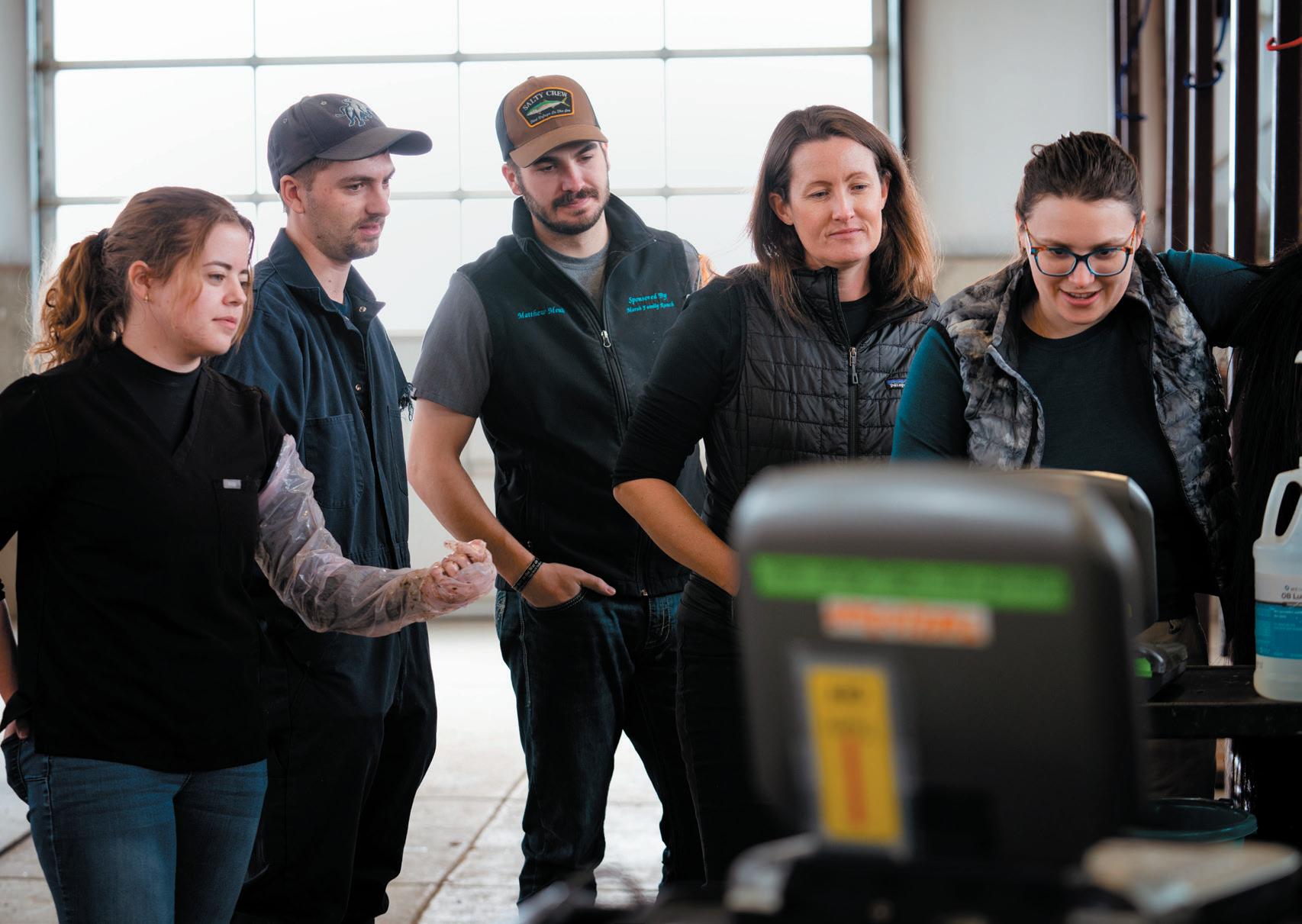
In April, Utah State University’s College of Veterinary Medicine hosted four former students for a clinical rotation focused on equine theriogenology, or horse reproduction. Each of the students began their journey in the WashingtonIdaho-Montana-Utah Regional Program at USU before moving on to complete their degrees at Washington State. But one month before graduation, these four came back to USU to hone their equine medicine skills.
During the two-week rotation, the students performed breeding soundness exams, palpations, artificial insemination, ultrasounds, and more at USU’s Sam Skaggs Family Equine Education Center which is home to the university’s equine
teaching and breeding herd. The students worked primarily with horses under the mentorship of Clinical Associate Professor Dr. Holly Clement, director of USU’s equine sciences program. They also treated cows and sheep at USU’s Animal Science Farm, working with Clinical Assistant Professor Dr. Rusty Stott.
McKenna Walters developed her interest in theriogenology during her first two years at Utah State, and she returned for the rotation because of the unique large animal learning opportunities USU offers.
“Getting this hands-on experience is a huge confidence booster for going out into the field,” said Walters. “You can learn about something, you can watch videos on it, you can watch everyone else do it.
But until you do it yourself, you don’t have that confidence. We’ve been scanning and palpating mares every single day now, so I know that when I go out into the field, I’ll be confident in doing that.”
Another student, Matt Barnes, attended USU for both his undergraduate degree and the first two years of vet school, so he was happy to visit with friends and former professors. But like Walters, he was most eager to build the muscle memory he’ll need for the rest of his career.
“If you're not the one doing the procedures, you're not going to have that confidence no matter how many times you've watched it,” Barnes said. “I watched Dr. Clement ultrasound mares for six years, and she makes it look
2 Winter 2023 IN THE COLLEGE
Working with horses at USU (left to right), McKenna Walters, Matt Barnes, Charles Lewis, faculty mentor Dr. Holly Clement, and Gabriella Greene-Dittz ultrasound a mare during a theriogenology rotation that brought these students back to Utah prior to graduation last spring.
ridiculously easy. And then the first day I tried it, I learned it’s not easy at all.”
Even so, Barnes credited his years at USU for preparing him to participate in the rotation in the first place.
“I recently got a national scholarship from the Nandi Theriogenology Scholars Program,” Barnes said. “I was one of four people in the nation who got it, and if it wasn't for the experiences and mentorship I had here, it wouldn't have been possible.”
While Gabriella Greene-Dittz had less experience with veterinary medicine during her undergrad education, the small class sizes and hands-on learning at USU helped her adapt to vet school quickly. She pointed to opportunities like the theriogenology rotation as an important part of the educational experience at USU.
“Take every single opportunity that you can, especially if it means going out into the field,” advised Greene-Dittz. “Lecture time is valuable, but it’s recorded, so you can go back and catch up on what you need. But those practical experiences may be just one chance, and that's it. And even if it’s the fifth time you've pulled a calf or whatever, you want to get that experience while you can, because the next time, you might be on your own.”
Clement, who supervised the students, also emphasized the importance of clinical rotations in preparing students for their careers.
“This is a necessary preparatory phase of our professional development,” Clement said. “After graduation, the list of what you become responsible for shifts considerably
in many directions. Clinical rotations are the culmination of four years of professional education meant to empower students to become effective and well-rounded veterinary practitioners upon entering the profession. They’re an essential phase of our training so that we can uphold the Veterinarian’s Oath and do right by our patients, clients, and the community.”
For Greene-Dittz and the other students, the rotation came at just the right time.
“I feel like this has been a really good revisit of those lessons right before we're going out into the big, bad world to do the work ourselves,” said Greene-Dittz. •
By: Ethan Brightbill


Congratulations to our class of 2023!
4 Winter 2023 { UTAH STATE UNIVERSITY VETERINARY MEDICINE } IN THE COLLEGE
Back Row, Left to Right:
Heather Hamblin, Nikki Jensen, Logan Center, Dalton Pils, Jon Stott, Briggs Fulton, Braden Tye, Dustin Clements , Trevor Berry, BrieAnna Burnett
Center Row, Left to Right:
Elizabeth Park, Heidi Lewis, Joe Goldhardt, Matt Barnes, Sarah Bradley, Makenna Koslosky, Charles Lewis, Mattison McMillan, Shelby Mobley, Emily Mora, Christine Qui
Front Row, Left to Right:
Brittany Estell, Tanille Paniogue, McKenna Walters, Kyra Goldhardt, Madison Bigler, Winnie Mefford, Gabi Greene-Dittz, Theda Parker, Delaney Carnahan, Beth Crandall •
USU College of Veterinary Medicine Dean's Advisory Board
The College of Veterinary Medicine is pleased to introduce the members of the Dean’s Advisory Board, a group of seasoned and young professionals with a blend of business acumen and veterinary expertise. The board is poised to work with the dean and other administrators to help guide the college with strategic decision-making. Their collective insight as the college develops will foster innovative curricula, forge industry partnerships, and ensure the college aligns with evolving professional landscapes. Advisory boards are invaluable bridges between academia and industry. We are thrilled to embark on this collaborative journey, where board members’ diverse experiences will shape the future of veterinary education and practice.
Dr. Richard Reeves - Board Chair
Dr. Richard Reeves graduated from Utah State University in 2005 with a bachelor’s degree in bioveterinary science. He went on to complete his DVM degree at Western University of Health Sciences in 2009.
Dr. Reeves spent the last 14 years in private practice as a general practitioner and recently partnered to purchase Cache Meadow Veterinary Clinic. As a professional, he has found tremendous satisfaction creating meaningful relationships with clients and their beloved pets. He is the founding chair of the Dean’s Advisory Board and is supported by a wonderful wife and four children.
Dr. Susan Benson
Dr. Susan Benson is from Northern Utah and earned her undergraduate degree from Utah State University. She attained her DVM at Colorado State University. She currently works at an American Animal Hospital Association-accredited practice and has a special interest in responsible dog and cat breeding. She also enjoys working with small ruminants and camelids. In addition to her work duties, Dr. Benson regularly teaches in the community to improve animal healthcare, volunteers at career fairs, speaks at American Kennel Club events to promote healthy breeding practices and responsibilities, and is involved with USU’s College of Veterinary Medicine as a communications coach. Her family donates considerable time to Junior Livestock 4H and FFA programs throughout the year.
Dr. Benson is active at the local and state level with organized veterinary medicine, including through the Cache Veterinary Practitioner’s Association and the Utah Veterinary Medical Association, the latter of which she currently serves as president. She is a past recipient of the UVMA Veterinarian of the Year Award.
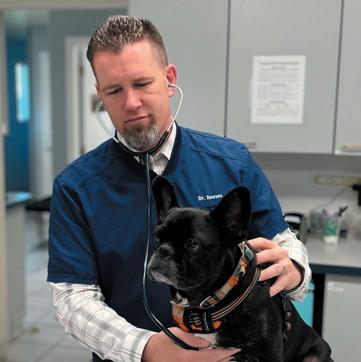

2023 Winter 5 { UTAH STATE UNIVERSITY VETERINARY MEDICINE }

Dr. Isaac Bott
Ryan Bohm
Ryan Bohm, managing partner at Andina Advisors, embodies family values and integrity while striving to serve his clients with their wealth management needs. Ryan has been in the wealth management field since 2008 and has steered growth in several regional advisory firms. As a Certified Financial Planner™, Certified Private Wealth Advisor®, and Certified Exit Planning Advisor®, Ryan's training has positioned him well to advise his clients in a comprehensive planning process.
Ryan is a Utah State University graduate and former USU football player. He is devoted to his beautiful wife, Jeanna, and their four wonderful children. Ryan enjoys coaching youth sports, playing golf, and dropping a dry fly on one of the local streams.
Dr. N. Isaac Bott is a 2009 graduate of the Washington State University College of Veterinary Medicine. He owns and operates Mountain West Animal Hospital, a mixed-animal veterinary facility in Springville, Utah. He currently serves on several national and state veterinary boards and is a past president of the Society for Theriogenology, an international group of veterinarians with expertise in animal reproduction. In 2023, he was awarded the Dr. John Steiner Award for Practitioner Excellence. He also served as a council member and chair of the American Veterinary Medical Association’s Council on Veterinary Service and as co-chair of the Utah Veterinary Medical Association’s Legislative Committee.
Dr. Bott currently serves as the AVMA delegate to the Society for Theriogenology. He has extensive experience with strategic planning, legislative process, and organizational leadership. He is also the author of over a dozen peer-reviewed scientific articles and has traveled the globe providing theriogenology services for camelids and cervids.
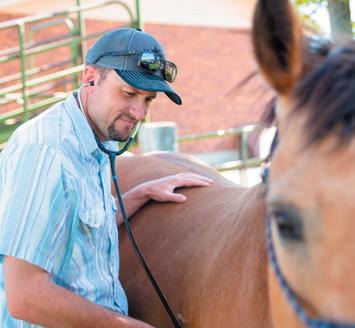
Dr. Phillip Firth

Dr. Phillip Firth was born and raised in Malad, Idaho. He did his undergraduate work at Brigham Young University-Idaho and graduated from Washington State University with his Doctor of Veterinary Medicine degree.
Dr. Firth practices at Bear River Animal Hospital in Tremonton, Utah. While he especially enjoys working on horses and cows, he will practice on just about any animal. His professional interests include equine lameness and equine and bovine reproduction. Phillip loves spending time with his lovely wife, Angela and his pretty great children, Eli, Cole, and Saige.
Dr. Kyle Heaton
Dr. Kyle Heaton joined South Valley Equine in 2019. He earned a bachelor's degree from Utah State University and graduated from Washington State University (WSU) in 2015 with a Doctorate of Veterinary Medicine degree. After graduation, he completed a 1-year internship at Pioneer Equine Hospital in Oakdale, California, followed by a 3-year equine surgical residency and Master of Veterinary Science degree at Washington State University. Dr. Heaton is a diplomate of the American College of Veterinary Surgeons - Large Animal.
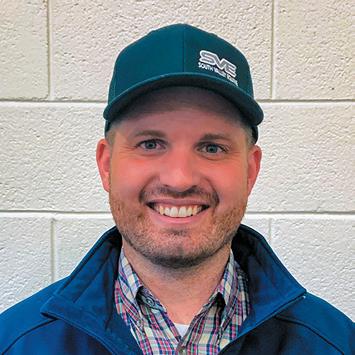
6 Winter 2023 { UTAH STATE UNIVERSITY VETERINARY MEDICINE }

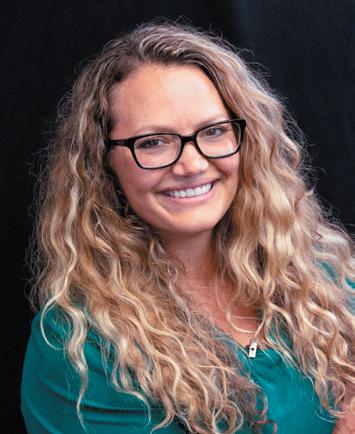
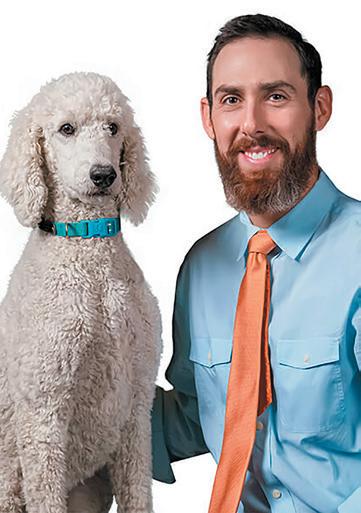
Dr. John Mathis
Dr. John Mathis was raised on a small family farm in southern Utah, where he developed a strong interest in livestock and agriculture. He graduated from Brigham Young University in 1977 and attended veterinary school at Colorado State University, where he graduated in 1981. He has practiced in Vernal, Utah for the past 43 years.
Dr. Mathis served as the mayor of Naples, Utah for eight years and in the state legislature for 10 years. As a member of the legislature, he was instrumental in establishing Utah State University's School of Veterinary Medicine, and was named the Utah Veterinarian of the Year by the Utah Veterinary Medical Association in 2010. Dr. Mathis' loves are his family, church, and profession.
Lindsay Ball
Lindsay Ball has always had a deep love and respect for animals. She earned her bachelor's degree from Utah State University in animal science with a minor in bioveterinary science. During an internship in Africa, she worked with great apes while trying to expose the illegal bush meat trade. She's diligently worked in the field for 25 years with some of Utah’s best and brightest doctors.
Ball is currently the lead surgical technician at Advanced Veterinary Care and oversees the Salt Lake City Canine Blood Hero donation program. She is always looking for ways to improve herself and learn new things while providing the best patient care. She functions well under pressure, demonstrates compassion, and always finds purpose as well as her passion in this field of work.
Dr. Jordan Scherk
Dr. Jordan Scherk, DVM, DACVECC, is a board-certified specialist in veterinary emergency and critical care at MedVet Salt Lake City. He attended the University of Florida before going on to earn his Doctor of Veterinary Medicine degree from Western University of Health Sciences. Following graduation from veterinary school, Dr. Scherk completed a small animal rotating internship at the Veterinary Specialty Center of Seattle followed by a three-year residency in emergency and critical care at the University of Georgia in 2013.
Dr. Scherk is experienced in all aspects of small animal emergency and critical care with specific areas of interest in trauma, mechanical ventilation, respiratory disease, metabolic emergencies, CPR, critical care anesthesia, and post-operative care. His favorite part of practicing emergency medicine is helping patients that don’t have a great chance of survival go home to their families.
When not caring for patients, you can find Dr. Scherk enjoying Utah’s outdoors — rock climbing, skiing, and snowboarding. He also enjoys cooking and hiking with his dog and children.
2023 Winter 7 { UTAH STATE UNIVERSITY VETERINARY MEDICINE }
Dr. Dainna Stelmach
Dr. Dainna Stelmach, DVM, MS, Diplomate, ACVR, is a board-certified veterinary radiologist at MedVet Salt Lake City. She earned a Bachelor of Science degree in biology from the University of Colorado. before attending the Western University of Health Sciences, where she earned a Doctor of Veterinary Medicine degree.
Dr. Stelmach completed a rotating internship at Equine Sports Medicine and Surgery followed by a residency in radiology and diagnostic imaging at the University of Georgia's College of Veterinary Medicine. Dr. Stelmach has practiced in Utah as a board certified veterinary radiologist since 2014.
Dr. Stelmach believes strongly in a collaborative approach to patient care and loves all modalities of diagnostic imaging. When away from the hospital, she enjoys hiking, skiing, camping, rock climbing, fishing, traveling, and spending time with her family.
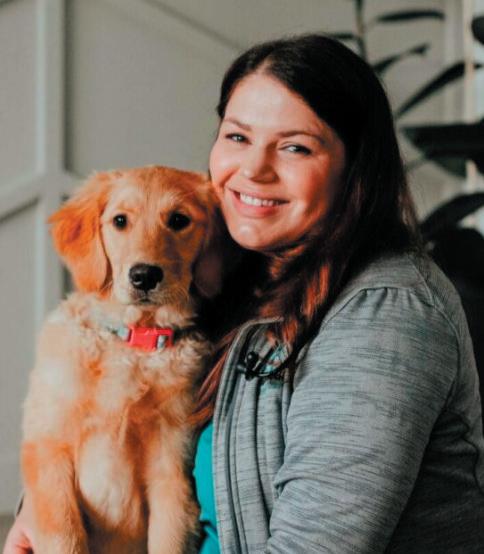
Dr. Amanda Vockler
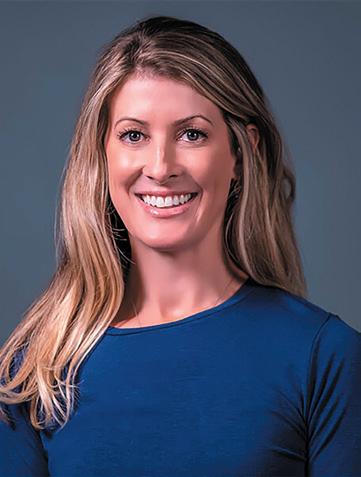
Dr. Amanda Vockler is a proud graduate of the first class (2016) of the Washington-IdahoMontana-Utah Regional Program in Veterinary Medicine and helped pave the way for the program's start in her home state. She attended Weber State University for her undergraduate degree and is proud to be on the Dean's Advisory Board and its youngest member.
As a Davis County, Utah native, Dr. Vockler is passionate about serving the local community that she grew-up in. In March of 2022, Dr. Vockler started Davis Mobile Veterinary Services as a result of her lifelong dream to run and own her own practice.
When not practicing, Dr. Vockler enjoys spending time with her husband and two kids, ages six and two.
Josh Webb
Joshua Webb was born and raised in south central Idaho on a dairy and cattle farming operation. He graduated from Utah State University in 2006 with a bachelor’s degree in agribusiness and worked as a credit officer in Twin Falls, Burley, and Idaho Falls before returning to the family operation as CFO in 2014. His current role is general manager of cattle operations, which includes a custom calf-raising business, dairy, cow-calf operation, and custom background and finishing yards.
He is excited to serve as a producer on the Dean’s Advisory Board and hopes to offer a unique perspective as someone who employs and works with veterinarians daily in his business. •
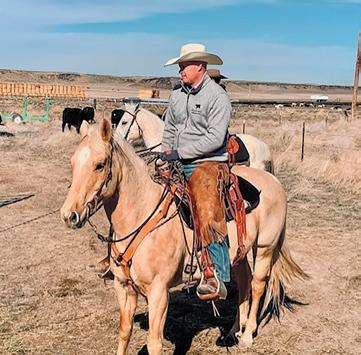
8 Winter 2023 { UTAH STATE UNIVERSITY VETERINARY MEDICINE }

Interim Dean Dirk Vanderwall Named Utah Veterinarian of the Year
Professor Dirk Vanderwall, interim dean of Utah State University's College of Veterinary Medicine is the Utah Veterinary Medical Association’s 2023 Veterinarian of the Year. Vanderwall was a vocal advocate for establishing the state’s only independent four-year veterinary medical program at USU.
The award ceremony was part of the Mountainlands Utah Veterinary Summit and was a surprise to Vanderwall who attributed the achievement to the help and encouragement he received in his career.
“When I received this recognition, I was truly honored and humbled,” Vanderwall said. “And while this is an individual award, it reflects the extensive support I've had from faculty, staff, students, and other administrators during my time at Utah State University.”
Collaboration has long been a hallmark of Vanderwall’s career. In 2003, while working at the University of Idaho, Vanderwall teamed up with veterinary scientist Gordon
Woods and Professor Ken White – now the dean of USU’s College of Agriculture and Applied Sciences – to create the world’s first equine clone, a mule named Idaho Gem. Sibling clones Utah Pioneer and Idaho Star soon followed, and in 2006, two of the mules went on to race and became the first cloned animals to compete athletically.
“That was a high point of my career, both professionally and personally,” Vanderwall said. “None of us could have done it individually, but bringing our strengths together gave us the critical mass of expertise to be successful. Between the friendships we developed and the scientific success of producing the world’s first equine clone, it was a tremendous experience. And while we were the team leaders, we also had a large group of veterinary, graduate, and undergraduate students involved in the ongoing work of that project.”
After leaving Idaho for the University of Pennsylvania in 2009, Vanderwall was re-
cruited to Utah State in 2012 with the start of the Washington-Idaho-Montana-Utah (WIMU) Regional Program in Veterinary Medicine, a collaboration with Washington State University’s College of Veterinary Medicine. He initially taught equine reproduction in USU’s Department of Animal, Dairy, and Veterinary Sciences and what was then USU’s School of Veterinary Medicine.
Now that Vanderwall is interim dean, he has relinquished his teaching role to focus on establishing Utah State’s four-year program.
“I’ve enjoyed a broad mix of teaching, research, and administrative responsibilities along with clinical work with the horses at the Sam Skaggs Family Equine Education Center,” said Vanderwall. “But now I need to step away from some of those activities. I taught equine theriogenology for the last time this past spring, and now I’m passing that on for my colleagues to teach in the future. There's a piece of me that I'm giving up by doing that, but it's in the best interest of the program and the students for me to focus on establishing the College of Veterinary Medicine.”
Vanderwall is excited for the day when the four-year college becomes a reality.
“I'm sure we’ll all breathe a sigh of relief once our new building is constructed, we've achieved accreditation, and the first class that will earn their doctor of veterinary medicine degrees at USU is admitted,” said Vanderwall. “And it will be so rewarding to then be able to reflect on the 11 years of the School of Veterinary Medicine and all the time and effort from the many people that went into making the four-year college possible.”
Vanderwall is especially grateful for his wife, fellow College of Veterinary Medicine adjunct faculty member Allison Willoughby.
“We’re a two-veterinarian family,” Vanderwall said. “Allison's always supported me throughout my career. Even as she’s maintained her own career as a veterinarian, she’s homeschooled our daughters, Madison and Morgan, and just been the rock of our family. I wouldn't have had the same success in my career without the support of all three of them.” •
By: Ethan Brightbill
2023 Winter 9
Meet Cathleen Kovarik, the College’s New Director of Admissions
As a professional practice associate professor, a member of the Utah State University College of Veterinary Medicine curriculum committee, former first-year coordinator, and part of the student progress committee, Dr. Catherine Kovarik has years of experience helping would-be veterinarians develop the skills they need to thrive.
She brings that experience and knowledge to her new position as the College of Veterinary Medicine’s new director of admissions. An important part of Kovarik’s mission for the planned four-year program is designing an application process that meets not just the needs of the college and veterinary profession, but also those of prospective students looking to enter the field.
“We want to reach out to more people, especially in rural, indigenous, and other underserved communities,” she said. “Our goal is for anybody who wants to be a veterinarian in Utah to know what is available to them and be able to structure their college courses so that they can come here and become a veterinarian.”
Because of the timing of the college’s creation and work to secure accreditation, Kovarik is working with Utah State University’s School of Graduate Studies rather than the Veterinary Medical College Application Service to design an application portal for students. She’s also devising the criteria the college will use to select students.
“Our goal is to look at the whole individual,” said Kovarik. “Not just their grades, but also their work experience, life experi-
ence, communication skills, and what hurdles they've had to overcome. Are they compassionate? Resilient? We want to give them credit for being who they are and set up a system that is transparent, equitable, and inclusive.”
Fortunately, this isn’t the first time Kovarik has been involved in the admissions process. When she was a faculty member in the University of Missouri’s College of Veterinary Medicine, she also served on that institution’s admissions committee and saw firsthand what made it successful.
“I learned a lot there, and I loved the experience,” Kovarik said. “I really liked establishing a personal connection with each applicant so that during the interview, we could talk to them as a person. The application process is hard on students — I could see the red climb into their necks and faces as the interviews went on, and I felt terrible for them. It’s why we need to remember that every student is a human being, and each one of them wants to be here.”
The interview process, Kovarik explained, is a two-way street. While the university must determine if students can succeed in the program and how they will fit into the existing community, it’s also an opportunity for students to ask themselves what excites them about Utah State and decide if the school is best for them.
Kovarik teaches Foundations of Veterinary Neurology and anatomy classes in the first and second semesters of the current program at USU and explained that because of the small class sizes at the university, she

gets to know the students very well. One challenge she sees for students and administrators alike is ensuring students admitted to the College of Veterinary Medicine take care of themselves once they’re accepted into the program.
“Wellness is something we're very cognizant of,” she said. “We want students who respect their own needs, stay healthy, and treat themselves as well as possible during this four-year period because it can be a very rough time. I would tell students to try and find life balance as early as possible since that will get them into vet school and through the curriculum. They’ll also need it as a veterinarian.”
The other side of that balance, Kovarik advised, is leaning into the drive to learn about veterinary medicine and getting accustomed to rigorous studies early.
“I’d tell students to be passionate and not give up on their dreams,” she said. “I also recommend taking a lot of demanding undergraduate courses, especially in the sciences. Even if it's not a prerequisite, it sets you up for success in vet school by proving to yourself that you can do this, and it helps you become passionate about the work.” •
By: Ethan Brightbill
10 Winter 2023 { UTAH STATE UNIVERSITY VETERINARY MEDICINE }
FACULTY/STAFF
Larrea Cottingham

Wildlife biology isn’t what most people imagine when they picture a summer job, but for second-year veterinary medicine student Larrea Cottingham, it’s nothing new.
Before joining the Washington-Idaho-Montana-Utah Regional (WIMU) Program in Veterinary Medicine, Cottingham earned a bachelor’s degree in biology and a master’s degree in teaching science from Northern Arizona University. At the time of this interview, Cottingham was conducting fieldwork in Colorado just a few weeks before returning to Utah State to begin her second year in the program.
How did you become interested in wildlife conservation?
Larrea Cottingham: I've always loved wildlife, and for as long as I can remember, I’ve wanted to work in wildlife conservation. I grew up in rural New Mexico and had an outside-based upbringing, so I spent a lot of time in remote places with a lot of wildlife, and I tried to save the bunnies and birds that came across our path.
As I got older, I realized that maybe an innate love for wildlife wasn't a shared value across all of society, especially when it comes to some of the animals that people are more fearful of or can't relate to, like snakes or insects. And that realization solidified what I view as my life purpose, which is protecting wildlife and advocating for all animals. Originally, I didn't even know that being a wildlife vet was a thing. I had a lot of animals growing up, but I only ever had one cat that needed to go to the vet for something other than a spay or neuter, so veterinary medicine wasn’t on my radar. I loved nature documentaries, books on animals, and people like Jane Goodall and Dian Fossey, so I just assumed that conservation biologists and experts on
particular species were the ones who did wildlife medicine. That’s what set me on the route to pursuing a bachelor of science in biology and wildlife fieldwork.
You’ve previously worked as a wildlife biologist, fifth- through seventh-grade teacher, and outdoor educator. How have those experiences affected how you approach earning your Doctor of Veterinary Medicine degree, and how do you think they’ll influence your work as a veterinarian?
Larrea Cottingham: When you look at my CV, it looks like I've done a bunch of random things, and it's not obvious how they fit together. But in my mind, each one of those pursuits was part of fulfilling the same goal, which is being an animal and wildlife advocate — preferably through adventure.
When I decided to be a teacher, it was because the research I did during my undergraduate years made me realize that without education and communication, all of the work we do to learn about animals is kind of moot if we can’t share it with the people who could
2023 Winter 11
STUDENT PROFILE
do something with that knowledge. It was also something I enjoyed and was good at.
I pivoted into outdoor education after realizing the classroom wasn’t for me. Growing up, I played a lot of make-believe about going on adventures, and taking these groups of young people out to broaden their horizons and connect with the natural world also helped me fulfill that more adventurous side of myself.
I went back into wildlife fieldwork because I missed being with animals. Because of the seasonality of the work, I sometimes still did outdoor education, so it’s not as linear as I’m making it sound. And over the years, I spent a lot of time trying to figure out my step to make a bigger impact in wildlife conservation. I kind of imagined a job description for myself and tried to figure out the job title that fit that. Ultimately, I figured out that meant being a wildlife vet, and earning a DVM was probably the next step toward that goal. In a sense, becoming a vet is the culmination of all of these experiences. My background has helped me in vet school, especially when it comes to grit and stress management. The program is a massive endurance event with so many things going on at once, but I’ve been in a lot of stressful situations over the years, from extreme weather events and other life-or-death situations in the field to the interpersonal stress of being a teacher during the pandemic. It helps put into perspective which things deserve getting stressed out about and which things don’t, and that experience also makes it easier to kick my brain into gear when I do have to just push through something. Overall, I’ve maintained a decent school-life balance and am having a fairly enjoyable time here, which isn’t necessarily something I expected.
Speaking of which, you made it through your first year in the WIMU program, and you’re about to start your second. What’s your experience been like so far? What’s the greatest challenge you’ve faced, and what have you enjoyed most?
Larrea Cottingham: I’ll preface this by noting I’ve only done the first year, and I know the second year is going to be a lot more challenging, but as I said, I’m honestly really enjoying being back in school. I’m fortunate in that I’ve been able to work over the summer, so I don’t have to have a job during the school year, and it’s been really nice to focus on school. I’ve enjoyed being overwhelmed by all this information and then watching the pieces come together. I tried listening to some professional-level podcasts on different veterinary topics last year, and it all went over my head, but now I can listen to someone talk about a disease and have at least a preliminary understanding of the processes they’re talking about. That’s really satisfying.
Hands-on learning is of course a highlight. I tried to get some of those experiences before vet school, but people take you more seriously as a vet student since they know you’re capable. I got to shadow Virginia Stout, the veterinarian for the Utah Division of Wildlife Resources, during a day of mule deer captures and assessments, which was really cool. I’ve also enjoyed going to the Murray Humane Society to participate in spays and neuters.

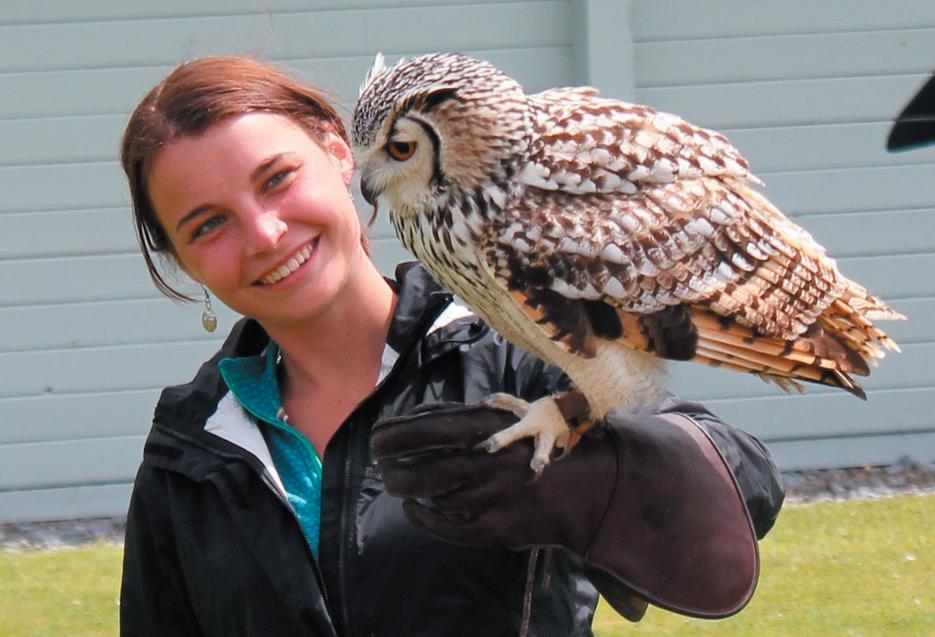
As far as challenges go, the greatest one hasn’t been about school or the program, but more something I see in the profession and society’s perceptions of animals. Our profession is dedicated to making the world better for animals, but sometimes there are obvious discrepancies between the way we treat dogs and cats versus animals used for agriculture. As someone who doesn’t eat animals or use animal products for ethical reasons, it’s been challenging to be reminded that species-based discrimination still exists, and not necessarily for reasons based in science. For instance, we know that other mammals in particular have the same ability to feel pain and experience suffering as cats and dogs, but for reasons of economics and culture and tradition, we treat them differently.
It’s a reality I have to engage with daily in my personal life, but it’s an added challenge to confront it professionally as well. At the same time, I find that tension motivates me to keep advocating for animal welfare, and I know that becoming a veterinary professional will help me to make a bigger difference in those spaces.
What advice would you offer to someone looking to follow your footsteps into wildlife veterinary medicine?
Larrea Cottingham: Well, I’m not a wildlife vet yet, so I think my advice will be worth more in a few years. But one thing I’m doing
12 Winter 2023
BARNYARD CHICKENS
By Jane Kelly, DVM, MS, MPH, Clinical Professor, DACVPM, DACVM
This case is loosely based on cases that have been received at the Utah Veterinary Diagnostic Laboratory, Spanish Fork.
A 10-month-old hen is submitted for necropsy. She is from a small flock of backyard chickens, five birds in total. Clinical signs noted by the owner include limping on the left leg, drooping of the left wing, and she had been off food and drink for 10 days prior to death and had stopped laying eggs for the previous few days. The bird has lost weight in the previous couple of weeks according to the owner. Necropsy findings are as follows.
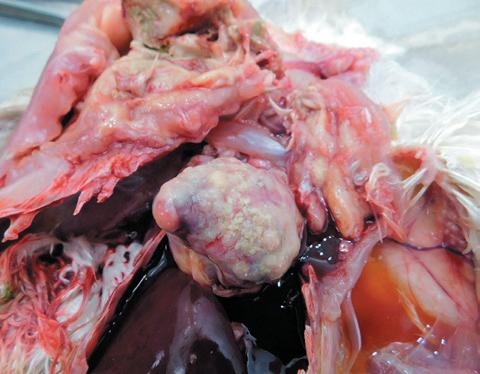
The right pectoral muscle is swollen and pale and a large tan, firm, irregularly shaped mass replaces much of the normal skeletal muscle. Yellow gelatinous fluid is in the coelomic cavity and distends the pericardial sac which is thickened and white (Figure 1). The heart is enlarged and much of the cardiac muscle is replaced by tissue similar tissue to that in the pectoral muscle. Also, the spleen is enlarged and the kidneys are swollen and pale. In addition, the wall of the proventriculus is thickened with a tan-to-white, firm material. Finally, several variable-sized tan, firm mass-

right now includes looking at wildlife job postings so I know what the requirements are and can create a map for myself to become qualified for those positions.
I know we all cringe at the term networking because of the connotation of being disingenuous. Definitely don’t make disingenuous connections. Do try to seek advice humbly and respectfully. For example, when Dr. (Ginger) Stout came and gave a presentation, I knew ahead of time that she was the wildlife vet for the State of Utah, so I emailed her beforehand and asked if she’d have time to talk afterward, making that convenient for her. Not everyone you reach out to will respond, and you don't want to be a burden. But if you start asking questions, people will gravitate toward you if you’ve done a lot of research, possess a high career drive, and have something to give back in return.
I think a final piece of advice is to not treat becoming a wildlife vet as something far away in the future, but to start considering yourself a wildlife professional now. If you want to work with wildlife, do that
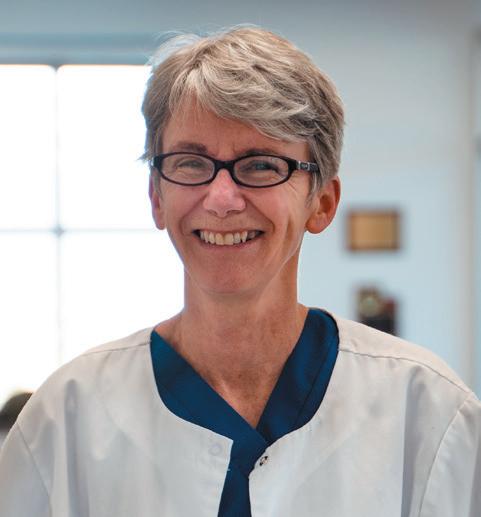
es are in the mesentery and, in some cases, expand into the intestinal wall. No other significant gross lesions are detected. Another hen from the same flock is submitted the following day and has a very enlarged, friable liver with multiple pale areas throughout (Figure 2).
Formulate your diagnosis and go to link for the answer and discussion. •
now in whatever capacity you can. Don’t wait to get your DVM to start building those skills. You’re living your life right now, so do the thing you love to do and don’t wait to work your way into the career.
What do you look forward to most when you graduate? What will veterinary medicine offer that your previous careers didn’t?
Larrea Cottingham: I'm just looking forward to all of the doors and opportunities that will open to me once I have my DVM. I have a pretty good idea of what's out there, but I know that once I have that degree, there will be so many more options. I'm really excited to bring this skill set to the places that need it and to continue working for the welfare of wildlife and domestic animals.
My childhood dream was to travel the world saving animals, and as silly as it sounded then, not much has changed. I hope that someday you'll find me doing just that. •
2023 Winter 13
Utah Veterinary Diagnostic Laboratory MYSTERY CASE
Find the the answer at vetmed.usu.edu/mystery
Figure 1
Figure 2
Leah Shumway
With life experience as a systems analyst, adjunct faculty, and a veterinary technician, Leah Shumway already has a wide range of professional skills and expertise. Now she’s a second-year student in the WashingtonIdaho-Montana-Utah Regional Program in Veterinary Medicine and well on her way to becoming a veterinarian even as she takes care of her family.
You had a successful career as a systems analyst for O.C. Tanner Co., an employee recognition company in Salt Lake City. What made you decide you needed a change of pace? And when did you become interested in veterinary medicine?
Leah Shumway: I’ve always been interested in medicine, and not just veterinary. When I was 12, I had to have bilateral Achilles tendon surgery, and as a result, I wasn't allowed to be in physical education class. The coach didn't know what to do with me, so she sent me to the library. The librarian gave me all kinds of VHS tapes of surgical procedures. For two weeks, I watched openheart surgeries and knee replacements. That’s what planted the seed and made me want to become a surgeon.
I started school at the University of Utah in 1993, planning to go into biology and probably pre-med. But I didn’t appreciate the gift I’d been given, and I gave up a full-ride scholarship. That decision ultimately landed me at O.C. Tanner Co. for 12 years, where I broadened my skills. In 2004, I moved away from full-time work to working at home. I ultimately got the gift of staying home as a full-time mom when my second daughter arrived in 2006.
One of the hardest things about being a stay-at-home mom that isn’t talked about a lot is how challenging it is to figure out your sense of purpose. Shifting gears from a daily job where you meet other people’s

expectations to suddenly not having that wasn’t easy. I had days when I felt lost, alone, and without direction. To bring back some structure, I decided to return to school and I earn my associate degree in veterinary technology from Broadview College.
What advantages or challenges did your previous career create when you decided to become a veterinary technician?
Leah Shumway: I think the benefit of my experience in a corporate environment was that it gave me lots of opportunities to grow in terms of communication and problem solving with other people. I was in a very technical role that required analytic skills, and I had to learn to work with people
and bring everyone along as a team. A lot of my personal growth happened at O.C. Tanner Co., and it helped me to interact with people in a kinder, more patient way, especially with clients. My mentors there helped me learn humility and empathy.
As for being a vet tech, the long hours made balancing family and career difficult. I was very lucky to acquire other positions that supported being a mom instead. I taught physical education and art to elementary school kids, and I was an adjunct professor at both Broadview and Utah Valley University for hematology, surgery, and microbiology lab. That teaching schedule allowed me to still make breakfast and lunch for the kids and go to activities and performances. That’s what I did until I decided to go back to school and refocus on veterinary medicine.
What were these years like for you, and how did they shape you into who you are today?
Leah Shumway: I think the benefit was that I learned a lot about myself. Being a stay-at-home mom exposes so much about who you are. Everything is self-directed, and if you’re impatient, angry, or unfocused, it brings those qualities to light. It’s amazing how kids can remind you to focus on the important things in life — not dishes or laundry, but playing, laughing, and running around in princess dresses. It gave me the opportunity to realize who I wanted to be without the pressure of a job or the expectations of fulfilling a career.
14 Winter 2023
STUDENT PROFILE
2014 was a turning point for me. I was working a part-time job for someone who didn’t know how to work with people, which made life miserable. Then my husband encouraged me to go back to school to become a doctor. I hadn’t thought that was an option anymore because of how long it had been, but it was incredible to realize I had this opportunity to pursue my passion. I didn’t have to worry about making money or what other people wanted me to be. I just got to go and see if it worked out. I’m very lucky to have had my family’s support.
After overcoming the fear of jumping back into college, I earned a bachelor’s in biology with an emphasis in microbiology from the University of Utah and then went on to work as a vet tech for a few years. With all of that in my tool bag, I entered the WIMU program in 2022. It’s been a lot of fun.
Now that you’re in vet school, what have you enjoyed most? And what’s the greatest challenge you’ve faced?
Leah Shumway: The WIMU program is exceptional, and the professors, instructors, and cohort are great people. USU’s smaller class size is something I very much appreciate. I know Utah State University is creating its own four-year program and going to get bigger, but the nice thing is that the professors are entering it from the perspective of this smaller program. They'll have an opportunity to incorporate some of the more intimate aspects into the new program.
The biggest challenge is balancing family and career. I’m pursuing my dream, but I also very much want to support and be part of my family’s lives — we are exceptionally close. My oldest daughter who attends USU lives with me, while my husband and other daughter still live in Riverton, about 100 miles south of Logan. I usually drive between 400 and 1000 miles a week to support my goal of being a mom to both of my daughters even as I try to find time to study and participate in the program.
To give you an example, I drove up to Logan and back to Riverton yesterday, I drove back up this morning, and I'll drive home again tomorrow. And I still shop for my
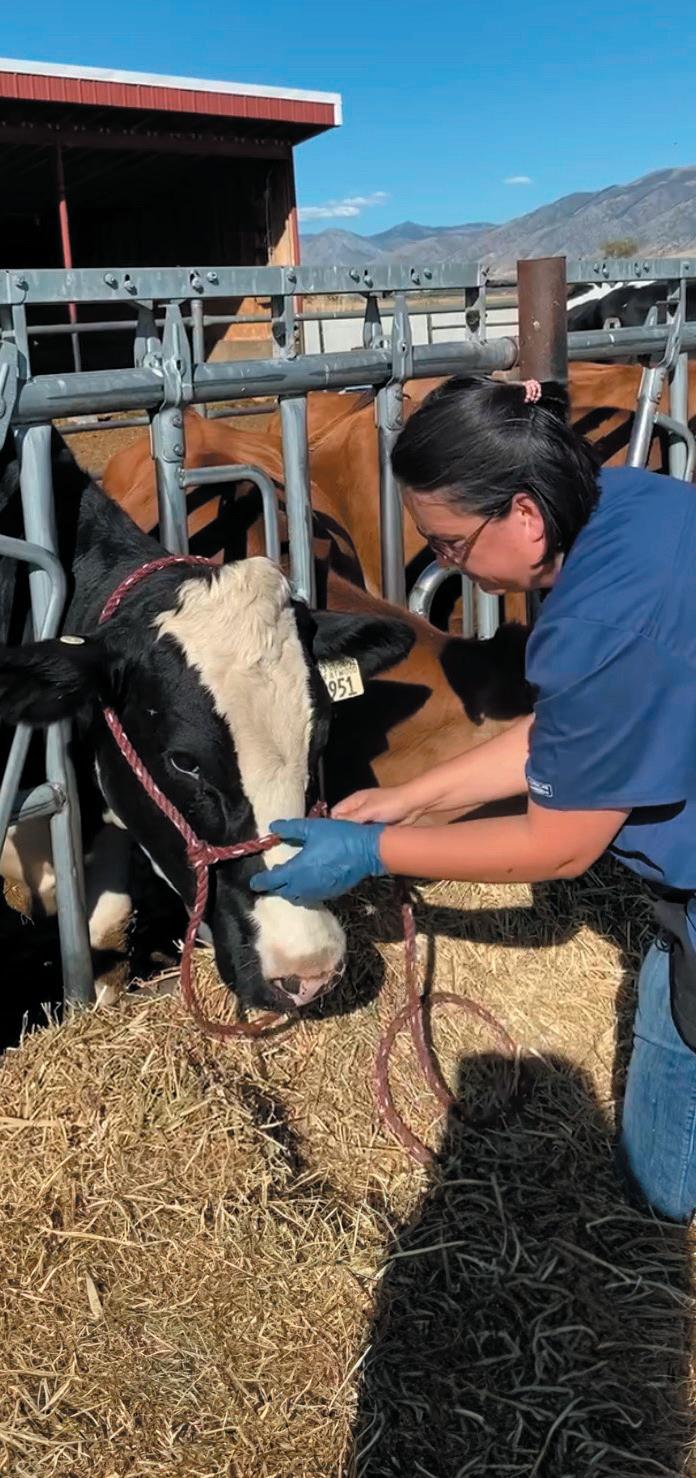
family, plan meals, and make lunches on the mornings when I can. Balancing being a wife and parent with all of this learning is hard, and the program is not really conducive to having anything else in your life. Whether it's a spouse, kids, or another passion, you don't get to pursue that easily when you're in vet school.
The last two years in the WIMU program are held at Washington State University’s Pullman campus. What are your thoughts on how you’ll approach the transition?
Leah Shumway: It will be challenging. In fact, the three ladies of our household will each be in different states. My youngest daughter will go to Colorado on a volleyball scholarship, I’ll go to Washington, and my oldest daughter will stay at Utah State. I’ve been married for 25 years, and my husband is spectacular! His idea is to attend some volleyball games for my youngest daughter
and be at home in Riverton so that when my Utah Stater comes home, she has a place to feel comfortable. The hope is that we’ll be able to see each other once or twice a month, but yeah, it’s going to be a big transition. On the upside, I get to learn more about surgery and medicine in an exceptional facility in Pullman, Washington.
What are you looking forward to most after graduation, and what do you hope your future will look like in five years?
Leah Shumway: I’m so excited to become a veterinarian. I love being a vet tech, and I know that I have a lot more to offer to pets and their humans. Being able to do surgeries and provide more advanced care is really what gets me ready to study for nine hours a day!
My dream for five years from now is to work in a mixed rural practice with great mentors and the pleasure of helping animals live better lives.
What advice would you offer to other students looking to follow your example?
Leah Shumway: People shouldn’t think they need to decide what they’re going to be at age 20. This was my 30th year after graduating high school, and I never would have thought I’d be here, yet here I am.
The road to get to this point was long. I initially started the program during 2020 and then COVID hit. I first got into the program during the COVID year, but my husband lost his job, so I deferred for a year to stay home and care for family. The next year, I started the program again but realized after two weeks later that I couldn't be away from my family yet, and I got sick and was in a car accident just in those weeks. Fortunately, the amazing WIMU administrators allowed me to try one more time. I’m now in the fall semester of my second year and learning so much every day. It’s a wonderful experience!
Vet school is easier if you're single and don't have a lot of attachments, but ultimately, it doesn’t matter if you’re 30, 40, 60, or whatever. If you have a passion for something, you shouldn't let life hold you back. •
2023 Winter 15

Going Home and Giving Back
with Rachel Keckler Hanson
Dr. Rachel Keckler Hanson doesn’t remember a time when she didn’t want to be a veterinarian. When she participated in junior rodeo and her local 4-H club, veterinarians were always there to ensure her family’s animals were fit to participate. And when she was in fourth grade and her first horse developed colic, a veterinarian came out to help — even though he ultimately couldn’t save the horse.
“We lived far out of town near the Idaho-Montana border, and we couldn’t afford surgery, so all the vet could do was tube Spook with some mineral oil and basically say ‘Good luck,’” she said. “He gave his best effort, but it wasn’t enough. And I was young, so I said that when I grew up, I’d cure colic. I now know that’s impossible, of course, but it was one of the driving forces that pushed me to shoot for this career.”
After moving to Fort Hall, Idaho, Keckler Hanson and her family turned to Animal Health Clinic in nearby Blackfoot for their veterinary medicine needs. She also made her career aspirations known to the clinic’s veterinarians, Drs. Jason Moulton and Sarah Jacobsen, and they encouraged her dreams. She spent a day shadowing the
veterinarians at the clinic when she was only 12 years old, and after taking zoology and other classes in high school, she arranged for more extensive time at the clinic before heading off to college.
Her time at the clinic gave rise to a practice Keckler Hanson would maintain even during vet school: a comprehensive logbook of her journey to becoming a veterinarian.
“Each day, I would write down exactly what happened,” she said, “and I asked the vet to sign it each time for proof that I’d done all of these things. I made a copy of the book and took it to my vet school interview, and they thought it was funny that I went to such lengths to log my hours. But I continued to carry that logbook through vet school, and it's been nice to be able to look back on all those memories of good days and bad days alike.”
While earning her undergraduate degree at Utah State University, Keckler Hanson served as the USU Rodeo Team’s vice president and worked in Dr. Ralph Meyer’s laboratory researching stallion fertility. During summers, she returned to Blackfoot to work as a veterinary technician with Jacobsen and Moulton. After three years, she was accepted into the Washington-Idaho-Montana-Utah (WIMU) Regional Program in Veterinary Medicine.
Keckler Hanson earned good grades in vet school, but she also found herself questioning her abilities. Her classmates were also people who had been at the top of their classes during their undergraduate studies, so it felt like the standard for success had changed.
What helped her to adjust was the USU Animal Science Farm. In addition to time spent there as part of her classes, Keckler Hanson volunteered to help out with C-sections and other procedures as often as she could, even if it meant skipping class once or twice. And while those hands-on experiences pushed her out of her comfort zone, they also taught her it was okay to make mistakes.
Just as importantly, they also gave her a place where she felt she belonged.
“I felt useful at the farm,” said Keckler Hanson. “Even if I did poorly on an exam, I was out there so much that I knew what my professors needed before they asked me. I was there so often that when undergraduate students showed up to observe sheep and goat embryo transfer surgeries, I would show them how to draw blood and where to shave and scrub them while other vet students scrubbed in for surgery. Those experiences showed me I had the skill set, made
ALUMNI
me realize I enjoyed helping and teaching others, and gave me the confidence to know I could do anything else in the program.”
After graduating from the WIMU program in 2022, Keckler Hanson returned to Animal Health Clinic as a full-time veterinarian. Her skill and adaptability were quickly put to the test.
“I’m a rural mixed practice veterinarian, so while the majority of what we see is dogs, cats, horses, and cows, we see everything,” she said. “One day, I’m ultrasounding 600-plus head of cattle, while another, I’m doing shots before the races at the state fair. I might work in the clinic performing dog and cat spays and neuters, or I might vaccinate buffalo for the Shoshone Bannock Tribes. We’ve had skunks, raccoons, and even a kangaroo with lumpy jaw.”
Although the variety of patients is one of the best parts of the job, being one of the only clinics in the area to take after-hours emergencies also comes with stressful situations. Keckler Hanson’s first night on call proved to be an extreme example. She received word that a horse with colic needed care, so she went to the clinic and prepared to receive the patient. After an hour, however, no one showed up.
she’d originally planned on finding a job elsewhere, a trip back to Blackfoot during her fourth year in vet school made her realize it was the place she was meant to be.
“I was just home,” said Keckler Hanson. “I knew the clinic, the technicians, and a lot of the clients. My dad lives five miles down the road from me, and my grandparents are close. We have another graduate from the WIMU program on staff, Dr. Erin Hansen. And working with Dr. Jacobsen and Dr. Moulton has a funny dynamic — they remember me as a little kid asking them a ton of questions, and now I'm still asking them a ton of questions. It’s a big family.”
Living in the area meant that Keckler Hanson could contribute to 4-H and other programs that had fostered her interest in veterinary medicine. She also set up a scholarship at Utah State to help students follow in her footsteps. While the amount each student receives is small, she hopes the recognition of receiving the scholarship will push them to persevere.
“A $500 scholarship compared to the cost of education is nickels and dimes,” she said. “But thinking back on my own experience, just
“We see people on the worst days of their lives, and our job is to be an advocate for both the animal and the client, even when people are stressed and emotions are high...You just need to learn to roll with it and grab on to all the good things.”
“I called the client, but there was no answer,” she said. “Then I got a call from the client a few minutes later, and she was distraught. There had been a car accident, and her horses were stuck in their trailer. I told her I’d be right there, and when I arrived, firefighters were using the jaws of life on the trailer to open the door because it was so smashed in.”
The client, Keckler Hanson learned, had been stopped by road construction with a car and motorcycle behind her. A truck then came up and hit the entire line of vehicles. None of the other drivers survived, and the buddy horse that was in the trailer to keep the colicking horse company broke its femur. Keckler Hanson had to put the animal down.
Surprisingly, the colicking horse survived. Keckler Hanson became close with the client and their family, and she did the prepurchase exam for the horse when the owners eventually sold it. The client even knit her a winter cap to show her gratitude.
For Keckler Hanson, that night illustrated what can be both one of the most challenging and rewarding parts of being a veterinarian: being there for people in their time of need.
“We see people on the worst days of their lives,” she said. “And our job is to be an advocate for both the animal and the client, even when people are stressed and emotions are high. Sometimes you make a mistake and people are angry, and sometimes you make no mistakes and people are still angry. You just need to learn to roll with it and grab on to all the good things. People can be really grateful, even when things don’t work out perfectly.”
Returning to Animal Health Clinic also meant that Keckler Hanson has a strong support network for times her job gets tough. While
being chosen is a boost. On hard days when you doubt yourself, it’s proof that someone selected you and that your efforts are recognized. And having more scholarships gives more people the opportunity to feel acknowledged that way.”
Keckler Hanson’s scholarship is designed to be awarded to students who take advantage of the hands-on learning opportunities at the USU Animal Science Farm.
“I wanted the clinicians at the farm to have input on choosing a student who’s out there and willing to make mistakes, learn, and get their hands covered in poop when needed,” she said with a laugh. “It’s about rewarding people who put in the work and giving them a boost to get through the grunt work. As Dr. Rusty Stott says, ‘Don’t let school get in the way of your education.’”
While Keckler Hanson is now in a position to help future veterinarians, she also continues to receive support from the Utah State community.
“Your classmates and professors become family,” she said. “I presented a paper at a Society for Theriogenology conference in Alabama recently, and Dr. Stott came and listened. And I’m working on another paper with Interim Dean Dirk Vanderwall and a professor from Washington State University, Dr. Ramanathan Kasimanickam, that looks at follicle size in draft horses. They were my mentors before, but those relationships carried on, and now they’re my colleagues. That’s the best part of the WIMU program, and especially Utah State.” •
By: Ethan Brightbill
2023 Winter 17
Jumping Into the Mudhole: Dr. Jake Miller’s Path to Buying His Own Animal Hospital
Dr. Jake Miller has a thriving business at the Bear Lake Animal Hospital now, but when he bought the practice in 2018, his future was uncertain. Providing veterinary services in a rural area can be a challenge in the best of times, but with a young family to support, Miller needed to find his footing quickly. It took long hours, support from fellow veterinarians and family, and a bit of faith to secure a future for the only veterinary hospital in the Bear Lake Valley, just north of the Utah/Idaho border.
Before he wanted to be a veterinarian, Miller enrolled at Utah State University to become an agricultural education teacher. He was just starting the coursework for his teaching degree when two encounters changed his mind. First, an interview with Buddy Daimler from the Utah Department of Education made Miller realize how strictly regulated the teaching profession can be, especially at the high school level. Second, Dr. Patricia Talcott from Washington State
how the chances of getting into vet school are so low and how miserable it can be to go through it. I just knew that I needed to try and be the person that gets in somehow.”
As Miller began to plan his new career, Utah State was moving on plans of its own to offer the first two years of a Doctor of Veterinary Medicine degree through what became the Washington-Idaho-Montana-Utah (WIMU) Regional Program in Veterinary Medicine.
“It was fun to watch the program come to fruition,” said Miller. “I watched classmates who were just a couple years ahead of me apply to be part of the first class in 2012, and as an ambassador for the College of Agriculture and Applied Sciences, I tried to get high school students to do their undergrad degree here and then apply to the two-plus-two program. I also remember Professor Kerry Rood, my undergrad professor in animal anatomy and physiology, talking about meetings with the state leg-
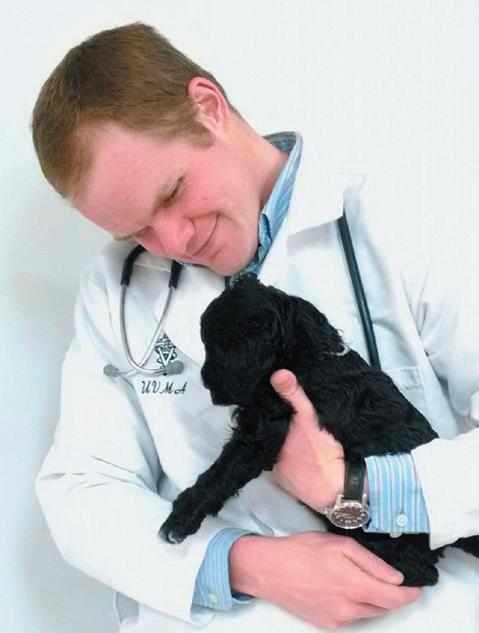
“I really enjoyed the close-knit classes and contact with our professors,” Miller said. “Going up to WSU was still a good experience, but when you go from a class of 32 students to a lecture hall of over 100, it's
“There’s only one reason that a veterinarian shouldn’t be able to do a spay successfully, and that’s if they believe they can’t do it. If you want to get into a business, if you want to be a successful ophthalmologist or orthopedic surgeon or whatever, you’ve got to start somewhere. And sometimes, that’s just putting on your shoes, jumping into the mudhole, and slogging forward.”
University’s College of Veterinary Medicine came to Utah State to give a recruiting lecture — and she told her audience how unlikely it was that any of them would make it into vet school.
“I sat in on the lecture and thought about being a vet,” said Miller. “And she spoke about
islature and encouraging students to write letters to our state representatives in favor of creating the program.”
After Miller earned his bachelor’s degree, he applied to the WIMU program and was accepted. The small size of his class helped him quickly form connections.
very different. And I feel like you can have a much better learning experience in that smaller environment, so I lucked out in a lot of ways by spending those first two years at Utah State.”
By Miller’s third year, he knew he wanted to own his own practice someday, but
18 Winter 2023
IN THE FIELD
he had no intention of doing so right out of vet school. Every veterinarian Miller spoke to recommended going to an existing practice with plenty of senior doctors who could act as mentors, so when his father-in-law decided to sell his animal hospital, it didn’t even occur to Miller that he could be the person to buy it.
“I was visiting with a fourth-year student, Nathan Whiting, and explaining to him that my father-in-law had been trying to sell the practice for a few years,” Miller said. “I told Nate he should be the one to buy it. He turned to me and said, ‘Well, why aren't you buying it?’”
The question stayed with Miller as he completed the final two years of his DVM. And after a preceptorship with Mountain West Animal Hospital’s Dr. Isaac Bott (see page 6), he received the motivation he needed.
“Isaac is still one of my heroes,” Miller said. “He’s such a good guy who’s done so much for the profession and industry. He’d acquired his clinic not that long ago, and by rubbing shoulders with him and discussing the business side of things, it solidified in my mind that I could do it. I could buy my own practice.”
Miller bought Bear Lake Animal Hospital in Montpelier, Idaho, in June 2018 shortly after graduating. With almost no other veterinary practices in the greater Bear Lake area and his father-in-law on a church mission to Uruguay now that the hospital was sold, Miller was truly on his own as he learned how to run a business while practicing medicine.
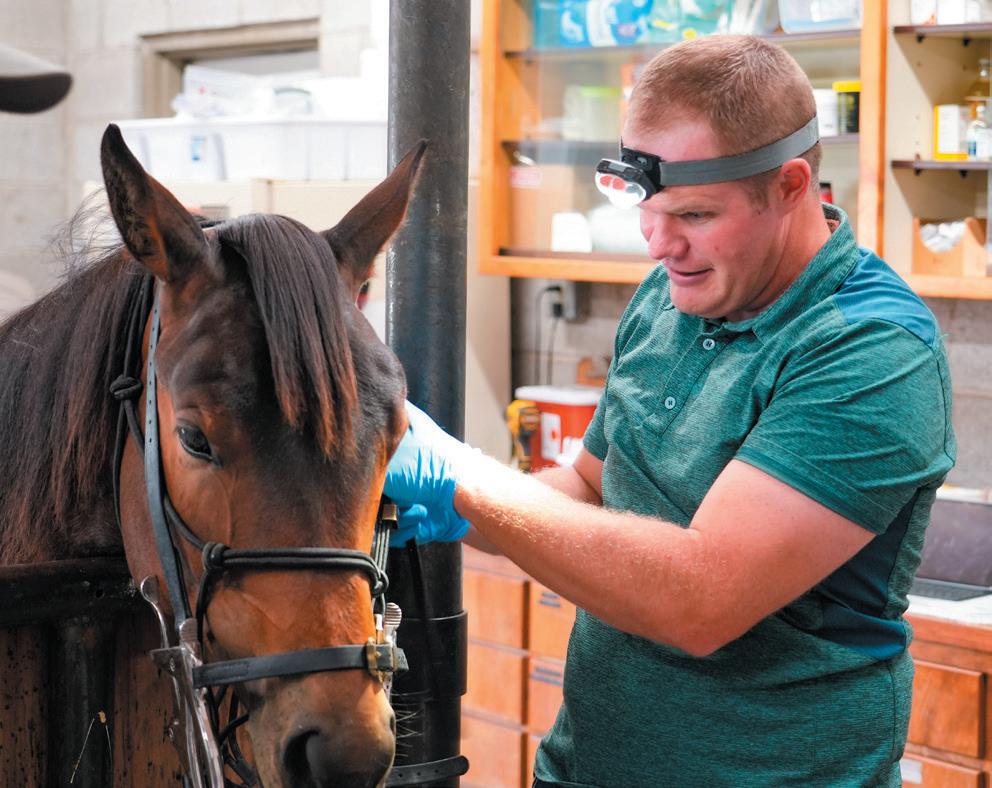
At first, he only had a couple patients a day. He made more money in his first month from boarding animals than providing medical care, and Miller himself was the one who took the dogs out of their kennel for walks. There were no technicians or receptionist, and while Miller’s wife was able to help sometimes, she had her hands full with three young boys to raise.
Beyond Miller’s own hard work and determination, there were a few factors that helped him pull through. First, he received
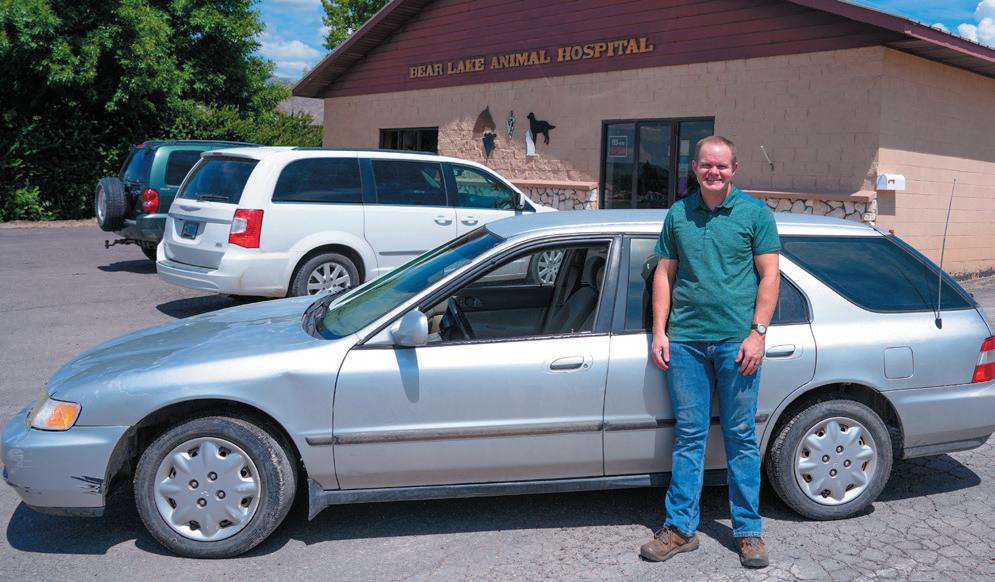
assistance through the U.S. Department of Agriculture’s Veterinary Service Grant Program in the second year of the practice, which let him update essential equipment like blood analyzers, ultrasound machines, and even a pickup truck for farm calls.
“Initially,” said Miller, “my mobile service was just my little ’97 hatchback Honda. In the wintertime, farmers told me to give them a call if I ever got stuck so they could pull me out of the ditch. Luckily, it never came to that.”
Miller’s wife, Shannon Miller, also plays a major role in the business’s success.
“She’s in the background making everything happen,” said Miller. “She does all of our marketing and advertising from our hospital promotions to our big community events like Baby Animal Days of Bear Lake. She’s our office manager now, and if you look at our website, that’s all her. Yet her name is rarely published, and she doesn’t get enough recognition for that.”
Miller also noted the impact the business had on his children.
“We’ve sacrificed a lot of family time to make this work,” he said. “The kids dread on-call weekends for dad because it can get busy, and they often end up praying that their dad doesn’t have to go in for emergencies.”
2023 Winter 19

Running the business is still a challenge, but it’s gotten easier over time. Miller was able to bring on fellow veterinarian and former USU classmate Trevor Redden last January, and the hospital now has dedicated receptionists and veterinary assistants. Miller was ambivalent about whether he took the best approach to buying his own practice.
“Would I do it again? Probably, because I don’t know any better,” Miller joked. “But it wasn’t an easy road.”
Yet in the end, Bear Lake Animal Hospital has become better and more successful than what Miller hoped it could be.
“I love the variety we get in a rural area like Montpelier, Idaho,” said Miller. “I can go
from vaccinating a puppy to doing an exam on a chinchilla to performing surgery on a snake to castrating a colt in a single day. And that makes life fun and exciting as a veterinarian. And then, as a business owner, the variety is just the same. I go from ordering inventory one second to dealing with an employee issue to visiting with a veterinarian about a complicated case.”
When asked what advice he would offer new veterinarians, Miller suggested that one of the greatest obstacles they face is just the tendency to say “No” to themselves and not try new things.
“There’s only one reason that a veterinarian shouldn’t be able to do a spay successfully,” Miller said, “and that’s if they believe they can’t do it. If you want to get into a business, if you want to be a successful ophthalmologist or orthopedic surgeon or whatever, you’ve got to start somewhere. And sometimes, that’s just putting on your shoes, jumping into the mudhole, and slogging forward.” •
By: Ethan Brightbill
Photos: Dennis Hinkamp
PET MEMORIAL GIVING
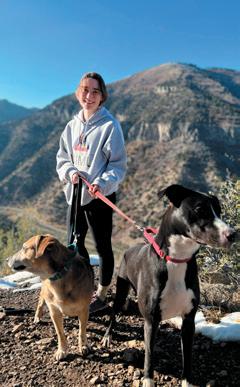

After losing a pet, many people take comfort in the knowledge that they provided the best life possible for their companion. Utah State University’s Pet Memorial Giving Program offers an opportunity to extend your pet’s legacy by funding research, student scholarships, and building infrastructure in the College of Veterinary Medicine. By supporting the next generation of great veterinarians, you ensure that animals in Utah and elsewhere get the medical attention they need to enjoy long and happy lives.
20 Winter 2023 { UTAH STATE UNIVERSITY VETERINARY MEDICINE }
You can donate on our secure website at
, or just
the
For more information, contact
development director for the
College of
THANK YOU TO OUR PET MEMORIAL DONORS
Meadow
Clinic |
(Davis
Town & Country Veterinary Hospital |
|
vetmed.usu.edu/give-back
scan
QR code.
Nik Aardema,
USU
Veterinary Medicine, niklas.aardema@usu.edu, 435-797-0767.
Cache
Veterinary
Dr. Amanda Vockler
Mobile Veterinary Services)
Dr. Paul Mardis
Todd Olson
Caring for Students Is No Act
When Barbara Troisi took her dog to the veterinarian, there were a few things off. First was the consultation room, which was dominated by an enormous one-way mirror. Second was the number of doctors: five instead of the usual one. And then there was Troisi’s dog, Walter, who appeared to suffer from not only lethargy and a lack of appetite, but also a chronic case of being a plush toy.
The scene was part of Utah State University’s 2023 diagnostic challenge, an event where students participate in mock clinical cases based on real scenarios encountered by veterinarians. As the simulated client in the challenge, Troisi interacted with students as if she was a concerned pet owner. She told them Walter’s history, ruled out certain treatments as being outside of her mock budget, and even asked for a senior discount.

“I receive a case study about three or four weeks in advance,” said Troisi, “And I memorize the script and convey it word for word. Because it describes the condition of the animal, it needs to be accurate.”
The challenge lasts for four days, and the animal’s condition continues to deteriorate on the first three. Students must not only diagnose the patient’s affliction, but also provide a list of treatments, price each option, and help their client choose a course
of action. On the fourth day, students present a full account of their case.
“The hardest part for me is writing evaluations,” Troisi explained. “I want to be objective and as fair as I can to help them develop their skills. But it’s also gratifying to see their presentations and witness everything they’ve accomplished. That makes me proud.” •
By: Ethan Brightbill
Read more about Barbara Troisi’s care of future veterinarians and other Aggies at vetmed.usu.edu/news/barbara-troisi
MESSAGE FROM DEVELOPMENT
Irecently had the privilege of planning and attending the first ever USU College of Veterinary Medicine Donor Recognition Banquet.
How wonderful it was to hear stories from so many of our donors and see the smiles on our students’ faces as they got to meet and interact with their scholarship donors. While I was there, I was reminded of a conversation I had several years ago with Matt White, vice president for USU Advancement. Matt has worked at many institutions across the nation and told me the following:
“I’ve been at a lot of institutions, and everywhere I go, everyone always talks about it being a family,” he said. “But Utah State is the first place I’ve come where people actually MEAN it.” I think Matt is spot on.
Everyone who gets involved with Utah State, whether they are students, faculty, staff, or friends of the institution, is an Aggie, and they are part of the Aggie family. The college is incredibly privileged to bring so many new people into the Aggie family, and their passion,
excitement, and love of animals everywhere will do great things for the future of veterinary medicine.
Our college has come a long way since joining the Washington-Idaho-Montana-Utah Regional Program in Veterinary Medicine in 2012, and it has a long way to go yet. However, I am confident that with the support of our friends and colleagues — our Aggie family — we will achieve great things for our community and make significant impacts in the lives of our students. •
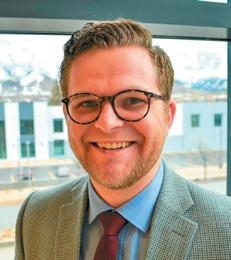 NIKLAS AARDEMA
Director of Development, USU CVM
NIKLAS AARDEMA
Director of Development, USU CVM
2023 Winter 21 { UTAH STATE UNIVERSITY VETERINARY MEDICINE }
IN THE FIELD
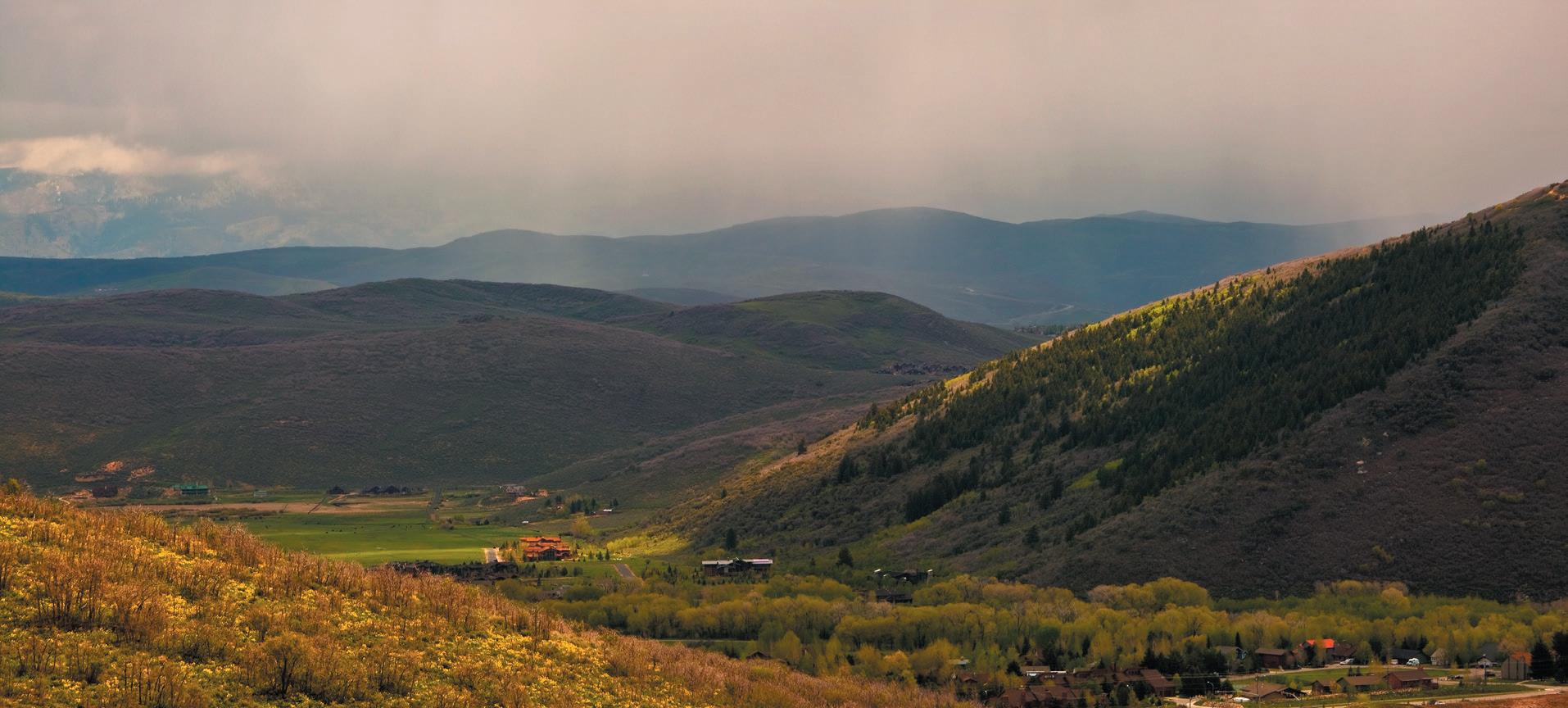

4815 Old Main Hill Logan, Utah 84322-4800 VETMED.USU.EDU NON PROFIT U.S. POSTAGE PERMIT 1 LOGAN, UTAH PAID Utah State University Logan, Utah OCT 18-20 Mark your calendar and plan to join veterinarians from around the state for networking and continuing education opportunities. MOUNTAINLANDS UtahSummitVeterinary 2024 For more information, please contact Dr. Kerry Rood, kerry.rood@usu.edu. HOSTED BY:











































 NIKLAS AARDEMA
Director of Development, USU CVM
NIKLAS AARDEMA
Director of Development, USU CVM

